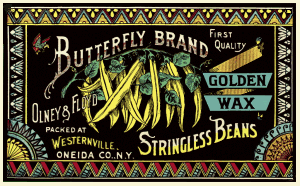For most of the thousands of years that humans have grown them, beans have had long, fibrous strings running along the pod seam (hence “stringbeans”) and a tough lining between the peas and the pod. The original bean farmers, native tribes in the Americas, raised beans to shell and discard the pods, not enjoy fresh what we generally know today as green beans. There are far more fresh, eatable beans than just green beans, of course, but that’s not we’re addressing today. We’re addressing the origin of those fresh snap beans, a dude named Calvin Keeney.
Keeney was born in 1849 in Le Roy, New York, a town just southwest of Rochester and 20-odd miles from Lake Ontario. When he was twelve, his old man started a produce company and did well selling dried goods to the Union during the Civil War. When Calvin was 23 he joined him. Twelve years later, in 1884, he developed Keeney’s Stringless Refugee Wax. He’d studied and bred and developed, worked 6,000 acres with his old man, and between that first wax bean and 1911, he developed 18 other new snap beans, all stringless, all sorted by hand before sale. Today, according to folks who know and whose credentials I don’t really feel the need to enumerate here, all stringless snap beans we eat descend from Keeney’s work. He became a rich man, owned quarries and cotton fields and lumber operations, etc., etc., all across the country. He incorporated later, and then joined up with other corporations later still to form ASGROW, now one of Monsanto’s duchies.


Pingback: Concrete Jungle: Pencil Pod Yellow Wax Beans, Manhattan Bridge, NYC | Pitchknives and Butter Forks